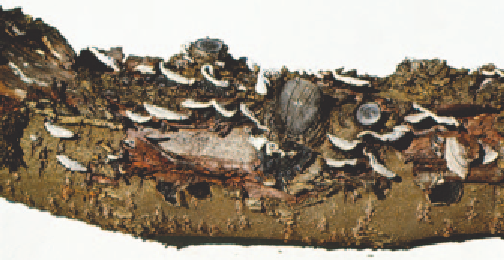Agriculture Reference
In-Depth Information
Management
•
Prune trees carefully and shape young trees to avoid the
necessity for large pruning cuts.
Treat cuts with the recommended wound dressing
to promote rapid healing.
•
FRECKLE AND SCAB
■
Cause
The fungus
Ve nt ur i a c ar pophil a
.
Fig 17.16 Small brackets of
Stereum strigosazonatum.
Symptoms
The disease affects peaches, nectarines and apricots. The
main symptoms occur on fruit, but leaves, twigs and young
branches can also be affected.
Trametes versicolor
: the brackets are up to 30 mm across,
with various coloured bands and a smooth surface on the
upper side and a honeycomb appearance on the underside.
Schizophyllum commune
: the brackets are soft, whitish,
with ragged edges and mushroom-like gills on the
underside.
Leaves: poorly defined, pale green or brown spots up to
5 mm wide develop on the underside. In extreme cases
these lesions can lead to defoliation.
Twigs: raised lesions are found on the current season's
growth. Light brown to begin with, the lesions become
darker later on in the season. The lesions do little direct
harm to the trees, but act as major sources of inoculum carry
over by providing a site for spore survival over the winter.
Tra m e t e is ve l u t i n a
: this is similar to
Trametes versicolor
except that the upper side is hairy and the bands are grey
to brown.
Pycnoporus coccineus
: these are up to 70 mm across, bright
orange-red in colour with a honeycomb appearance on the
underside.
Fruit: circular, olive-green to black spots up to 2 mm wide
with poorly defined margins appear six to seven weeks
after petal fall. Spots are more common on the exposed
side of the fruit towards the stem end. A cork layer develops
below the spots and, as the fruit develops, it may become
distorted and crack.
Stereum strigosozonatum
: the brackets are small, leathery,
grey to brown in colour, with a polished black underside.
Source of infection and spread
The brackets produced on old branches and stumps of
native vegetation and deciduous fruit trees contain large
numbers of spores. Once released, the spores are carried
by the wind to nearby stone fruit trees where germination
occurs when conditions are suitable. Entry is usually
gained through damaged tissues, such as pruning cuts and
natural wounds. Once established, the fungus grows down
through the heartwood causing dieback as it progresses.
Source of infection and spread
The fungus overwinters in twig lesions. In spring, during
wet weather, the large numbers of spores produced spread
The condition is more common in mature trees that have
suffered from drought, hail, sun scald, mechanical root
damage, overcropping, poor nutrition or severe winter
pruning.
Trametes versicolor
and
Stereum strigosozonatum
are the
most serious fungi, the others being relatively weak
parasites generally found attacking declining trees.
Importance
Dieback is generally serious only where trees have been
badly stressed by severe pruning, sunburn, drought or deep
cultivation.
Fig 17.17 Freckle (scab) on young apricots.













